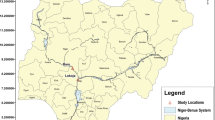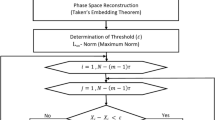Abstract
This paper investigates the dynamics of the time-series of water temperature of the Skokomish River (2019–2020) at hourly time scale by employing well-known nonlinear methods of chaotic data analysis including average mutual information, false nearest neighbors, correlation exponent, and local divergence rates. The delay time and the embedding dimension were calculated as 1400 and 9, respectively. The results indicated that the thermal regime in this river is chaotic due to the correlation dimension (1.38) and the positive largest Lyapunov exponent (0.045). Furthermore, complex networks have been applied to study the periodicity of thermal time-series throughout a year. A special algorithm is then used to find the so-called communities of the nodes. The algorithm found three communities which have been called Cold, Intermediate, and Warm. The temperatures in these three communities are, respectively, in the intervals (0.8, 5.8), (5.8, 11.63), and (11.63, 15.8). This analysis indicates that highest variations in water temperature occur between warm and cold seasons, and complex networks are highly capable to analyze hydrothermal fluctuations and classify their time-series.














Similar content being viewed by others
Code Availability
The code generated during the current study are available from the corresponding author on reasonable request.
Data Availability
The datasets used in this study were compiled and supplied by the U.S. Geological Survey. They are available from the corresponding author on reasonable request.
References
Abarbanel H, Parlitz U (2006) Nonlinear analysis of time series data.Handb Time Ser Anal WILEY-VCH1–37
Abarbanel HDI (2001) Challenges in modeling nonlinear systems: a worked example. Nonlinear dynamics and statistics. Springer, pp 3–29
Abarbanel HDI (1996) Reconstruction of Phase Space. Analysis of observed chaotic data. Springer, pp 13–23
Azra MN, Aaqillah-Amr MA, Ikhwanuddin M et al (2020) Effects of climate‐induced water temperature changes on the life history of brachyuran crabs. Rev Aquac 12:1211–1216
Barabási AL, Pósfai M (2016) Network Science. Cambridge University Press
Bärlocher F (2007) Molecular approaches applied to aquatic hyphomycetes. Fungal Biol Rev 21:19–24
Benyahya L, Caissie D, St-Hilaire A et al (2007) A review of statistical water temperature models. Can Water Resour J 32:179–192
Caissie D (2006) The thermal regime of rivers: a review. Freshw Biol 51:1389–1406
Canning DJ, Randlette L, Haskins WA (1988) Skokomish River comprehensive flood control management plan. Washingt Dep Ecol Rep 87:24
Clauset A, Newman MEJ, Moore C (2004) Finding community structure in very large networks. Phys Rev E 70:66111
Delafrouz H, Ghaheri A, Ghorbani MA (2018) A novel hybrid neural network based on phase space reconstruction technique for daily river flow prediction. Soft Comput 22:2205–2215
Di C, Wang T, Istanbulluoglu E et al (2019) Deterministic chaotic dynamics in soil moisture across Nebraska. J Hydrol 578:124048
Dugdale SJ, Hannah DM, Malcolm IA (2017) River temperature modelling: a review of process-based approaches and future directions. Earth Sci Rev 175:97–113
Elshorbagy A, Simonovic SP, Panu US (2002a) Noise reduction in chaotic hydrologic time series: facts and doubts. J Hydrol 256:147–165
Elshorbagy A, Simonovic SP, Panu US (2002b) Estimation of missing streamflow data using principles of chaos theory. J Hydrol 255:123–133. https://doi.org/10.1016/S0022-1694(01)00513-3
Ferreira LN, Ferreira NCR, Macau EEN, Donner RV (2021) The effect of time series distance functions on functional climate networks. Eur Phys J Spec Top 230:2973–2998
Ferreira LN, Zhao L (2014) Detecting time series periodicity using complex networks. In: 2014 Brazilian Conference on intelligent systems. IEEE, pp 402–407
Fraser AM, Swinney HL (1986) Independent coordinates for strange attractors from mutual information. Phys Rev A 33:1134–1140. https://doi.org/10.1103/PhysRevA.33.1134
Galka A (2000) Topics in nonlinear time series analysis: with implications for EEG analysis. World Scientific
Garcia S, Luengo J, Sáez JA et al (2012) A survey of discretization techniques: taxonomy and empirical analysis in supervised learning. IEEE Trans Knowl Data Eng 25:734–750
Ghorbani MA, Karimi V, Ruskeepää H et al (2021) Application of complex networks for monthly rainfall dynamics over central Vietnam. Stoch Environ Res Risk Assess 35:535–548. https://doi.org/10.1007/s00477-020-01962-2
Ghorbani MA, Kisi O, Aalinezhad M (2010) A probe into the chaotic nature of daily streamflow time series by correlation dimension and largest Lyapunov methods. Appl Math Model 34:4050–4057
Henry B, Lovell N, Camacho F (2001) Nonlinear dynamics time series analysis. Nonlinear Biomed signal Process Dyn Anal Model 2:1–39
Jackson FL, Malcolm IA, Hannah DM (2016) A novel approach for designing large-scale river temperature monitoring networks. Hydrol Res 47:569–590
Jayawardena AW, Gurung AB (2000) Noise reduction and prediction of hydrometeorological time series: dynamical systems approach vs. stochastic approach. J Hydrol 228:242–264
Jayawardena AW, Lai F (1994) Analysis and prediction of chaos in rainfall and stream flow time series. J Hydrol 153:23–52
Kantz H (1994) A robust method to estimate the maximal Lyapunov exponent of a time series. Phys Lett A 185:77–87
Kantz H, Schreiber T (2004) Nonlinear time series analysis. Cambridge university press
Karvonen A, Rintamäki P, Jokela J, Valtonen ET (2010) Increasing water temperature and disease risks in aquatic systems: climate change increases the risk of some, but not all, diseases. Int J Parasitol 40:1483–1488
Kennel MB, Abarbanel HDI (2002) False neighbors and false strands: a reliable minimum embedding dimension algorithm. Phys Rev E 66:26209
Kennel MB, Brown R, Abarbanel HDI (1992) Determining embedding dimension for phase-space reconstruction using a geometrical construction. Phys Rev A 45:3403–3411. https://doi.org/10.1103/PhysRevA.45.3403
Khatibi R, Ghorbani MA, Aalami MT et al (2011) Dynamics of hourly sea level at Hillarys Boat Harbour, Western Australia: A chaos theory perspective. In: Ocean Dynamics. pp 1797–1807
Khatibi R, Sivakumar B, Ghorbani MA et al (2012) Investigating chaos in river stage and discharge time series. J Hydrol 414–415:108–117. https://doi.org/10.1016/j.jhydrol.2011.10.026
Kim S, Noh H, Kang N et al (2014) Noise reduction analysis of radar rainfall using chaotic dynamics and filtering techniques
Lee M, Kim HS, Kwak J et al (2021) Chaotic features of decomposed Time Series from Tidal River Water Level. Appl Sci 12:199
Li J, Kong K, Cui C, Zhang Z (2020) Rainfall Data Reconstruction Based on Chaotic Characteristics of Meteorological Factors. In: IOP Conference Series: Earth and Environmental Science. IOP Publishing, p 12027
Markarian RK (1980) A study of the relationship between aquatic insect growth and water temperature in a small stream. Hydrobiologia 75:81–95
Marwan N, Donges JF, Zou Y et al (2009) Complex network approach for recurrence analysis of time series. Phys Lett A 373:4246–4254
Ng WW, Panu US, Lennox WC (2007) Chaos based Analytical techniques for daily extreme hydrological observations. J Hydrol 342:17–41. https://doi.org/10.1016/j.jhydrol.2007.04.023
Patra RW, Chapman JC, Lim RP et al (2015) Interactions between water temperature and contaminant toxicity to freshwater fish. Environ Toxicol Chem 34:1809–1817
Porporato A, Ridolfi L (1997) Nonlinear analysis of river flow time sequences. Water Resour Res 33:1353–1367. https://doi.org/10.1029/96WR03535
Ren K, Huang Q, Huang S et al (2021) Identifying complex networks and operating scenarios for cascade water reservoirs for mitigating drought and flood impacts. J Hydrol 594:125946
Ruskeepää H (2014) Analysis of chaotic data with Mathematica. https://library.wolfram.com/infocenter/ID/8775/
Shang P, Na X, Kamae S (2009) Chaotic analysis of time series in the sediment transport phenomenon. Chaos Solitons Fractals 41:368–379
Silva TC, Zhao L (2016) Machine learning in Complex Networks. Springer International Publishing
Sitzenfrei R, Wang Q, Kapelan Z, Savić D (2020) Using Complex Network Analysis for optimization of water distribution networks. Water Resour Res 56. https://doi.org/10.1029/2020WR027929. :e2020WR027929
Sivakumar B (2016) Chaos in Hydrology: bridging determinism and stochasticity. Springer Netherlands
Sivakumar B (2009) Nonlinear dynamics and chaos in hydrologic systems: latest developments and a look forward. Stoch Environ Res Risk Assess 23:1027–1036. https://doi.org/10.1007/s00477-008-0265-z
Sivakumar B, Jayawardena AW, Li WK (2007) Hydrologic complexity and classification: a simple data reconstruction approach. Hydrol Process 21:2713–2728. https://doi.org/10.1002/hyp.6362
Sivakumar B, Persson M, Berndtsson R, Uvo CB (2002) Is correlation dimension a reliable indicator of low-dimensional chaos in short hydrological time series? Water Resour Res 38:3–8. https://doi.org/10.1029/2001WR000333
Smith K (1975) WATER TEMPERATURE VARIATIONS WITHIN A MAJOR RIVER SYSTEM. Hydrol Res 6:155–169. https://doi.org/10.2166/nh.1975.0011
Sprott JC, Sprott JC (2003) Chaos and time-series analysis. Oxford university press Oxford
Stover SC, Montgomery DR (2001) Channel change and flooding, skokomish river, Washington. J Hydrol 243:272–286
Takens F (1981) Detecting strange attractors in turbulence. In: Rand D, Young L-S (eds) Dynamical Systems and Turbulence, Warwick 1980: Proceedings of a Symposium Held at the University of Warwick 1979/80. Springer Berlin Heidelberg, Berlin, Heidelberg, pp 366–381
Tao H, Sulaiman SO, Yaseen ZM et al (2018) What is the potential of integrating Phase Space Reconstruction with SVM-FFA Data-Intelligence Model? Application of Rainfall forecasting over Regional Scale. Water Resour Manag 32:3935–3959. https://doi.org/10.1007/s11269-018-2028-z
USGS (2020) National Water Information System: Web Interface: U.S. Geological Survey database. https://waterdata.usgs.gov/wa/nwis/uv?site_no=12056500
Vaheddoost B, Kocak K (2019) Temporal dynamics of monthly evaporation in Lake Urmia. Theor Appl Climatol 137:2451–2462. https://doi.org/10.1007/s00704-018-2747-3
Vega-Oliveros DA, Cotacallapa M, Ferreira LN et al (2019) From spatio-temporal data to chronological networks: An application to wildfire analysis. In: Proceedings of the 34th ACM/SIGAPP Symposium on Applied Computing. pp 675–682
Vignesh R, Jothiprakash V, Sivakumar B (2015) Streamflow variability and classification using false nearest neighbor method. J Hydrol 531:706–715. https://doi.org/10.1016/j.jhydrol.2015.10.056
Wang M, Tian L (2016) From time series to complex networks: the phase space coarse graining. Phys A Stat Mech its Appl 461:456–468. https://doi.org/10.1016/j.physa.2016.06.028
Wang S, Huang GH, Baetz BW, Ancell BC (2017) Towards robust quantification and reduction of uncertainty in hydrologic predictions: integration of particle Markov chain Monte Carlo and factorial polynomial chaos expansion. J Hydrol 548:484–497. https://doi.org/10.1016/j.jhydrol.2017.03.027
Webb BW, Nobilis F (2007) Long-term changes in river temperature and the influence of climatic and hydrological factors. Hydrol Sci J 52:74–85. https://doi.org/10.1623/hysj.52.1.74
Wichert GA, Lin P (1996) A Species Tolerance Index for Maximum Water temperature. Water Qual Res J 31:875–893. https://doi.org/10.2166/wqrj.1996.048
Funding
The authors declare that no funds, grants, or other supports were received during the preparation of this manuscript.
Author information
Authors and Affiliations
Contributions
Heikki Ruskeepää: Resources, Computer code, Visualization, Writing - Original Draft. Leonardo Nascimento Ferreira: Conceptualization, Methodology, Writing - Original Draft. Mohammad Ali Ghorbani: Supervision, Conceptualization, Methodology. Ercan Kahya: Investigation, Writing - Original Draft, Formal analysis. Golmar Golmohammadi: Investigation, Conceptualization, Resources. Vahid Karimi: Formal analysis and Investigation, Methodology, Writing - review and editing.
Corresponding authors
Ethics declarations
Competing interests
The authors have no relevant financial or non-financial interests to disclose.
Ethical approval
This article does not contain any studies with human participants or animals performed by any of the authors.
Additional information
Publisher’s Note
Springer Nature remains neutral with regard to jurisdictional claims in published maps and institutional affiliations.
Rights and permissions
Springer Nature or its licensor (e.g. a society or other partner) holds exclusive rights to this article under a publishing agreement with the author(s) or other rightsholder(s); author self-archiving of the accepted manuscript version of this article is solely governed by the terms of such publishing agreement and applicable law.
About this article
Cite this article
Ruskeepää, H., Ferreira, L.N., Ghorbani, M.A. et al. Nonlinear and periodic dynamics of chaotic hydro-thermal process of Skokomish river. Stoch Environ Res Risk Assess 37, 2739–2756 (2023). https://doi.org/10.1007/s00477-023-02416-1
Accepted:
Published:
Issue Date:
DOI: https://doi.org/10.1007/s00477-023-02416-1




